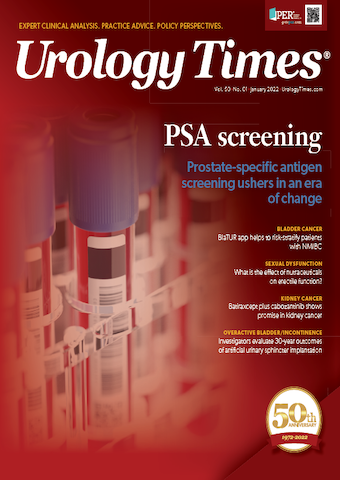Publication
Article
Urology Times Journal
Prostate cancer screening rates rise following USPSTF guideline update
Author(s):
Rates of PSA testing for prostate cancer have increased following a 2017 decision by the US Preventive Services Task Force (USPSTF) to no longer recommend against screening for the entire US population, according to a study from Yale Cancer Center.1
The recommendation against all screening was made by the USPSTF in 2012. The 2017 update somewhat reversed course and recommended that menaged 55 to 69 should make an individualized decision on PSA screening based on a risk-benefit discussion with their physician. For men aged ≥70 years, however, the USPSTF policy remained a blanket recommendation against PSA screening.
The Yale study found that the mean rate of PSA testing for men aged 40 to 89 from before to after the new USPSTF guideline was drafted and published (2016 to 2019) increased from 32.5 to 36.5 tests per 100 person-years. This translates to a relative increase of 12.5%.
Michael S. Leapman, MD

“The findings from our study are intriguing. Increases in PSA testing were expected based on renewed support the consideration of screening from the USPSTF. These findings underscore the importance of screening guidelines from the task force and the rapid responsiveness of clinicians and patients,” lead study author Michael S. Leapman, MD, stated in a recent news release.2
“However, increases in all age groups, including those for whom screening is not recommended, also highlight challenges to achieving a nuanced, evidence-based national approach to screening,” added Leapman, assistant professor of Urology, clinical program leader of the Prostate and Urologic Cancers Program at Smilow Cancer Center.
For the large, retrospective cohort study at Yale Cancer Center, deidentified claims data from Blue Cross Blue Shield beneficiaries were examined. The claims were from the date range of January 1, 2013, to December 31, 2019. Age-adjusted rates of PSA testing were estimated using bimonthly periods and compared from years before the USPSTF guideline change to years after.
Additionally, interrupted time series analyses were used to associate PSA testing rates to the initial April 2017 draft of the USPSTF guideline and the final May 2018 published guideline. Further analyses evaluated the differences in rates among various age groups, including men aged 40 to 54 years, 55 to 69 years, and 70 to 89 years.
Results showed that the median number of eligible beneficiaries for each bimonthly period was 8,087,565 (range 6,407,602-8,747,308) and the median age of these beneficiaries was 53 years (IQR, 47-59). In the 40 to 54 years group, mean rates increased from 20.6 to 22.7 tests per 100 person-years (10.1% relative increase). In the 55 to 69 years group, the rate increased from 49.8 to 55.8 (12.1% relative increase). In the 70 to 89 years group, the rate increased from 38.0 to 44.2 (16.2% relative increase).
Using the interrupted time series analysis, investigators also found that there was a significantly increased trend of all PSA testing after April 2017 among all beneficiaries (0.30 tests per 100 person-years for each bimonthly period; P <.001).
Xiaomei Ma, PhD

“The consequences of increased PSA testing remain to be appreciated. Further study is needed to better understand patient perspectives and potential quality of life implications for both younger and older men,” senior study author Xiaomei Ma, PhD, professor of Epidemiology, co-leader of the Cancer Prevention and Control Research Program at Yale Cancer Center, stated in the press release.
Reference
1. Leapman MS, Wang R, Park H, et al. Changes in prostate-specific antigen testing relative to the revised US Preventative Services Task Force recommendation on prostate cancer screening. Published online November 11, 2021. Jama Oncol. doi:10.1001/jamaoncol.2021.5143
2. Yale Cancer Center study shows rates of PSA testing for prostate cancer increased after revised national guidelines. Published online November 11, 2021. Accessed November 15, 2021. https://bit.ly/2YTIrKD.

































